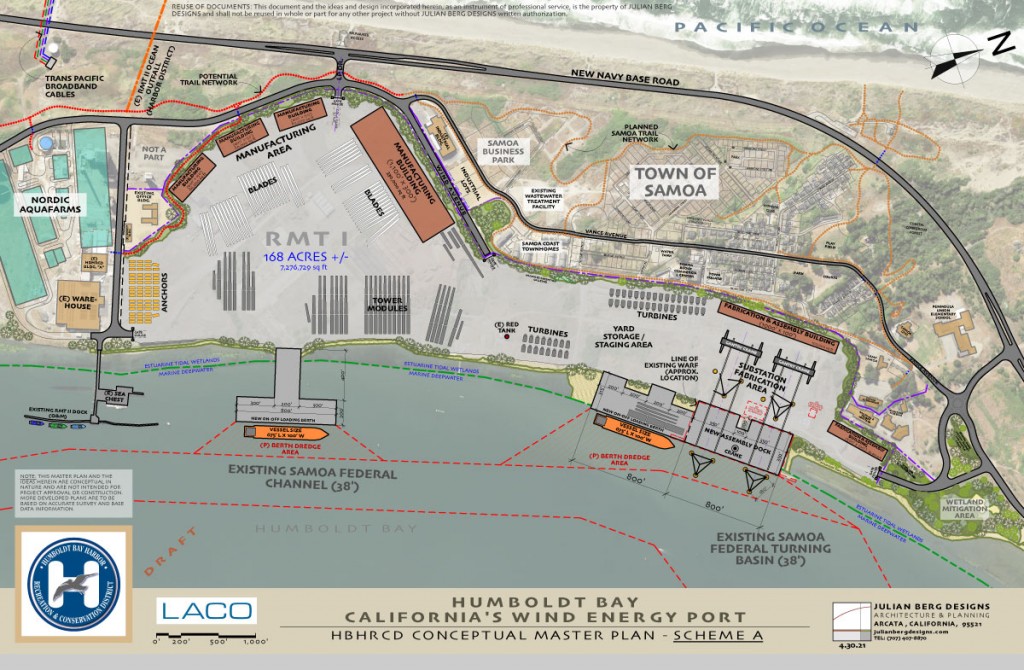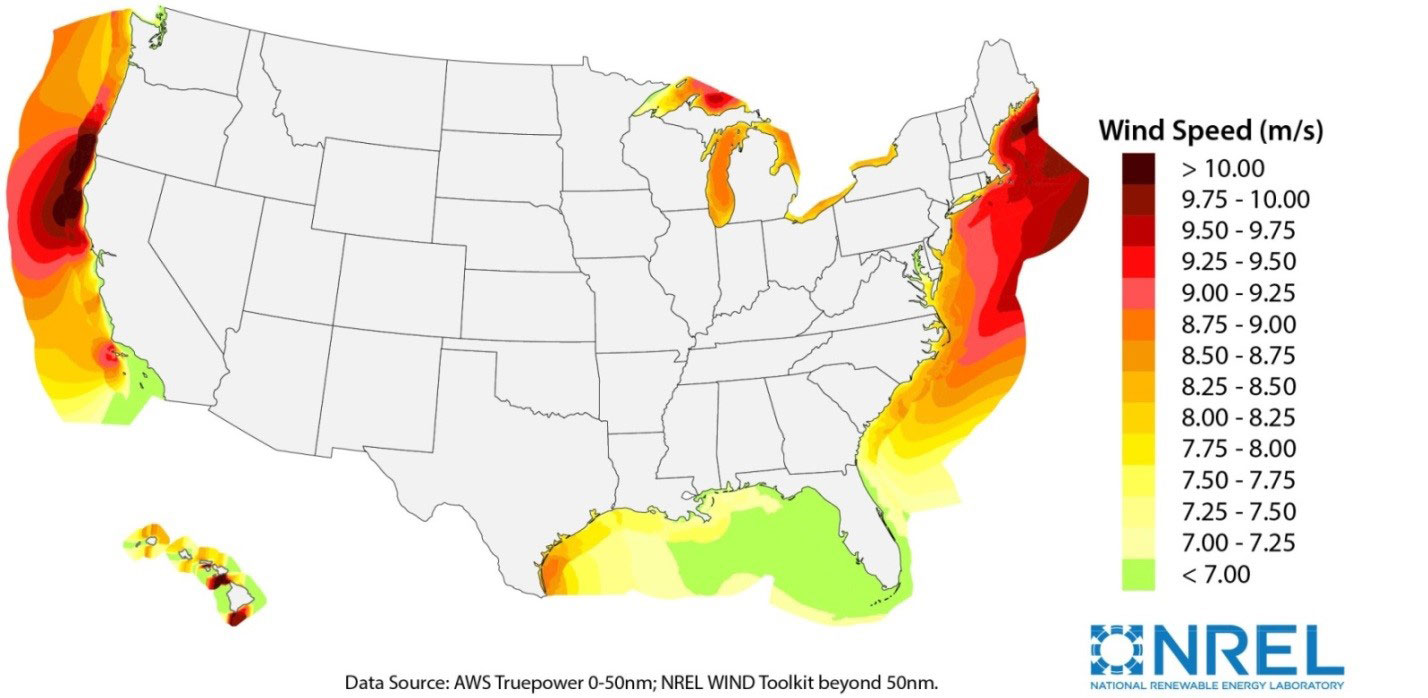The Biden Administration announced that the U.S. Departments of Interior and Defense have reached agreement on California sea-space and other issues, clearing the way to move ahead with development of the state’s multi-gigawatt (GW) offshore wind power potential on its Central and North coasts.
"This is the breakthrough California's offshore wind industry and workers have been looking for," said Adam Stern, executive director, Offshore Wind California, a trade group of offshore wind developers and technology firms.
Stern added: "We look forward to partnering with federal and state agencies to map out a path to achieve a minimum of 10 GW of clean, offshore wind power for Golden State residents and workers by 2040 ... An interim goal of 3 GW by 2030 will contribute to President Biden’s national goal of 30 GW by the end of this decade—from both the East and West Coasts. “
An additional 1.6 GW is proposed for wind farms off the coast of Humboldt Bay.
He added: “We commend the Departments of Interior and Defense, with support from Governor Newsom, for reaching this agreement. To meet these ambitious goals, we'll need to complete environmental reviews, upgrade port infrastructure, build offshore wind's supply chain, and streamline federal and state permitting while protecting wildlife and cultural resources… Responsible development of offshore wind will be essential for California to reach its clean energy goals and reduce its climate risks, while also creating thousands of high-skilled jobs and protecting marine and coastal resources.”

Central California
Stern told AJOT the agreement will expand the area that can be developed for offshore wind in Central California that is based off of Morro Bay.
This offshore power generation can flow directly into the California grid because the region has an estimated 5 GW in underutilized transmission capacity that can be upgraded without major cost to accommodate offshore wind farms.
This is significant because offshore wind developers can be sure that the first 5 GW generated by wind farms can be sold into California’s transmission system.
The Biden Administration announcement also encourages the California Public Utility Commission to work with California Independent System Operator to develop more transmission resources to support offshore wind farms.
The California Independent System Operator (ISO) provides access to the bulk of California’s wholesale transmission grid.
Proposed Wind Farm Port at Northern California’s Humboldt Bay
On May 14th, Governor Gavin Newsom committed $20 million in California's proposed FY 2021-22 budget as a down payment to spur offshore wind power.
Of this allocation, $11 million is earmarked as a match for $55 million U.S. Department of Transportation funds that will fund the offshore wind facility at Humboldt Bay. The total grant is $66 million.
Larry Oetker, executive director, Humboldt Bay Harbor District, told AJOT: “This is a game-changer for Humboldt Bay. After we lost a lot of our timber business in the 1990s, we also lost a lot of our maritime business. This will change with the offshore wind port…We are very grateful to the Biden Administration and to Governor Newsom.”
Oetker said that the environmental reviews for permitting the wind farms off Humboldt Bay will take 3-4 years and so a similar timeline is expected for the construction of the new port.
As part of the initial phase of the project, the existing 6-acre Redwood Marine Terminal would be completely replaced with a new modern heavy-lift terminal, and eel grass and other impacts would be mitigated, Oetker said.
This will be supported by an additional 40-acre tarmac uplands from the terminal.
To complement the economic investment in the new Port, the nearby Humboldt State University will be receiving $ 433 million to provide new resources to create a polytechnic university that supports advanced training and research, he said.
A jobs and skills assessment is currently under way and due to be published in July. This will identify workforce requirements that will be necessary to support the new port facility.
There will also be a focus on training welders and fitters and other skilled workers at the local community college, College of the Redwoods at Eureka.
The offshore wind facility will assemble wind turbines which will then be floated out to sea to become wind farms.

Northern California Wind Farm & Transmission Line
Stern noted that 1.6 GW of offshore wind farm development projected for Humboldt Bay, is restricted by the lack of transmission infrastructure to deliver electricity.
However, wind farms off Humboldt Bay could expand if an offshore transmission line to the San Francisco Bay Area is built. It is estimated that an underwater transmission line system linking Humboldt Bay to the S.F. Bay Area would be over 250 miles long and cost upwards of $3.1 billion, according to a 2020 Humboldt State University report.
The concept is similar to the Atlantic Wind Connection, an offshore transmission system proposed for linking offshore wind farms on the U.S. Atlantic coast, that was never built.
The report was produced by the Schatz Energy Research Center at Humboldt State University, Arcata, California and is entitled “California North Coast Offshore Wind Studies: Subsea Transmission Cable Conceptual Assessment.”
The report said that routing “a high voltage direct current (HVDC) transmission cable from the Humboldt Bay area to the San Francisco Bay (SF Bay) area would be intended to deliver power generated from an offshore wind farm(s) in the Humboldt area to load centers in the SF Bay area …. The subsea distance between SF Bay and Humboldt Bay (250 miles) necessitates the use of an HVDC electrical system to minimize electrical losses. The HVDC cable system would consist of the cable system itself and an HVDC converter station at each end of the transmission cable (Humboldt Area and SF Bay Area) to convert the power to/from the standard alternating current (AC) grid system.”
In total, 11 companies have applied for leases in both Diablo Canyon and Morro Bay off of the Central California coast, while 10 applied for spaces off of Humboldt Bay in Northern California, according to the Bureau of Ocean Energy Management.
The floating offshore wind turbines planned for California would be fastened to the ocean floor with cables and float on the surface of the sea. These turbines are based on deep sea designs that are necessary since California coastal waters are too deep to support traditional shallow draft offshore wind turbines built into the sea bed that are planned for the U.S. East Coast.

